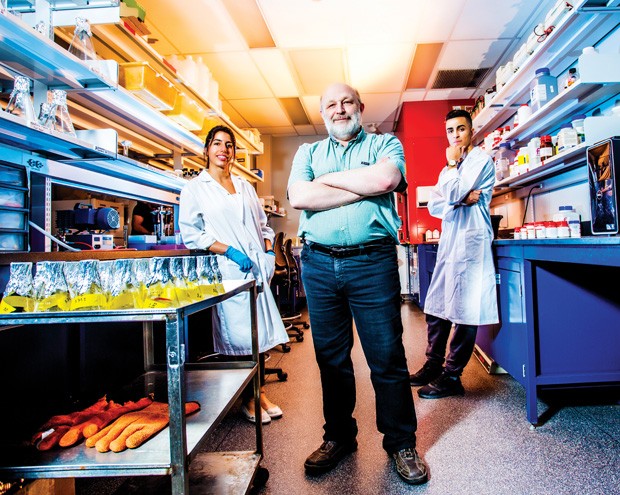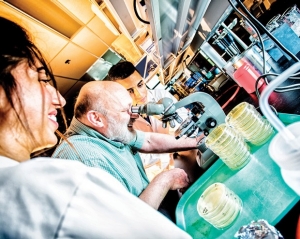Titorenko’s research on yeast cells is being carried out with the help of a team of graduate students he has recruited to see to the day-to-day operation of the lab. Each is assigned a specific function to perform in the process.
Pamela Dakik, BSc (biol.) 15, is exactly where she wants to be right now. Dakik has always had a passion for science, especially biology, and has followed that academic path since high school. Dakik now finds herself not only working on a major research project just a year after completing her undergraduate degree, but also fast-tracked to begin her PhD in September.
“I took a class with Titorenko and then started volunteering in his lab,” Dakik says of how she first became involved in the project. “I saw the work being done, and after two semesters I took a course where I had a chance to conduct hypothesis-driven experiments, working with the yeast cells and aging. I liked it so much that right after I graduated I applied for a graduate degree in Titorenko’s lab.”
Part of Dakik’s task is to screen a library of numerous plant extracts in a robust experimental procedure, which allows researchers to identify extracts capable of increasing yeast longevity by delaying aging of yeast cells. The plant extracts Dakik uses are supplied by Idunn Technologies, a scientific research and development company in Rosemère, Que., that specializes in natural health products, especially those associated with aging.
With the natural extracts, Dakik begins what is called the screening process aimed at identifying the most efficient aging-delaying natural products. “I start off by testing those numerous plant extracts with the yeast cells and try to see which of them can greatly extend yeast longevity and, thus, delay the aging process,” she explains. “After that, I try to determine the ideal concentration — as with any drug you take there are different concentrations: too high may be toxic, too low might not work.”
She then use genetic approaches to assess which pathways are targeted by each of the aging-delaying plant extracts. “I also look into the abilities of certain combinations of these plant extracts to delay aging more efficiently than each of them does individually,” Dakik says. “Once I answer those questions, the other grad students take a more in-depth look at how each of these plant extracts delay aging by impacting various processes in the yeast cell.”
For his part, Younes Medkour, BSc (biol.) 15, indulges his love of microscopy and systems biology to determine how and to what extent the yeast cells are affected by each of the aging-delaying plant extracts. “My role is to find what specific processes in various cellular organelles are altered by each of these extracts, and to understand why and how these alterations delay aging,” he says. “I use a combination of experimental approaches to answer these essential questions. These approaches include quantitative mass spectrometry of lipids and proteins, microscopy and bioinformatics.”
Medkour, who also fast-tracked his studies to begin his PhD in September, had initially intended to study biology as a prelude to medical school yet found himself bitten by the research bug after applying his computer skills in bioinformatics through Selvadurai Dayanandan, a professor in the Department of Biology. Medkour came to Titorenko’s attention when he presented his honours project aimed at understanding the mechanisms underlying cancer. This, he says, made it a lot easier for him when he later applied for a graduate research position in Titorenko’s lab.
Once there, everything changed for him. “When I saw the research that was going on, I said to myself, ‘This is where I belong, not in med school!’”
Amanda Piano, BSc (biol.) 14, MSc (biol.) 16, is currently pursuing a certificate in biotechnology at McGill University after completing both her undergrad and graduate degrees while working with yeast cells in Titorenko’s lab. “I was immediately drawn to the research being done in the Titorenko lab and initially joined as a volunteer to explore the prospect of a future in research,” says Piano, who found her passion for biology while a CEGEP student at Dawson College in Montreal.
“At Dawson, the biology classes were broad and general, but while at Concordia I found myself gravitating towards more specialized work in cell biology,” she recalls. “The intricacy and complexity of the cell and its workings always fascinated me.” Piano claims that Titorenko’s friendliness and dedication to his students combine to play a big role in the research team’s success. “He is devoted and approachable, which makes a great supervisor,” she says.
Cross-country partners
The experiments being carried out at Titorenko’s lab are currently focused on yeast; the work on actual cancer cells is being done at research facilities of other institutions by Titorenko’s longstanding colleagues and collaborators — each of whom have been working with lithocholic bile acid and have discovered its effectiveness in not only delaying the aging process but also killing the cells of neuroblastoma, prostate and breast cancers.
Among Titorenko’s primary research partners is Andréa C. LeBlanc, a professor of neurology and neurosurgery at McGill, who is a leading researcher at the Lady Davis Institute for Medical Research at the Jewish General Hospital. LeBlanc’s research with lithocholic acid has led to the discovery that it selectively kills cultured human neuroblastoma cells — a cancer that commonly attacks the adrenal glands.
Another collaborator, Troy A.A. Harkness of the University of Saskatchewan in Saskatoon, has done extensive research on the treatment of tumours and has worked closely with the Canadian Cancer Society. His experiments with lithocholic acid found that it selectively kills cultured human breast cancer cells as well.
Likewise, toxicologist Thomas Sanderson, associate professor at the INRS-Institut Armand-Frappier in Laval, Que., heads a research team whose work with lithocholic bile acid has determined that it selectively destroys cultured human prostate cancer cells.
While these discoveries are promising, they are currently restricted to Petri dishes and microscope slides. Titorenko says it will be a while before any of their findings will be applied to human subjects, as a further series of experiments on mice or other animals must first be completed in order to safely determine how their cells react to the lithocholic bile acid.
Titorenko admits that he and his fellow researchers are sometimes frustrated by the long research process — but at the same time he’s thankful to be working with yeast, as that has sped up the timeline by a considerable margin. “Of course we want to see the results very quickly,” Titorenko says with a smile. “But we must be patient.”
Related links
 “Quite simply, we study aging of baker’s yeast to understand how to slow aging and extend the healthy lifespan of humans,” says Vladimir Titorenko (centre), professor in the department of biology, of the experiments being carried out in his lab in Concordia’s Richard J. Renaud Science Pavilion. He is pictured with researchers Pamela Dakik and Younes Medkour.
“Quite simply, we study aging of baker’s yeast to understand how to slow aging and extend the healthy lifespan of humans,” says Vladimir Titorenko (centre), professor in the department of biology, of the experiments being carried out in his lab in Concordia’s Richard J. Renaud Science Pavilion. He is pictured with researchers Pamela Dakik and Younes Medkour.
